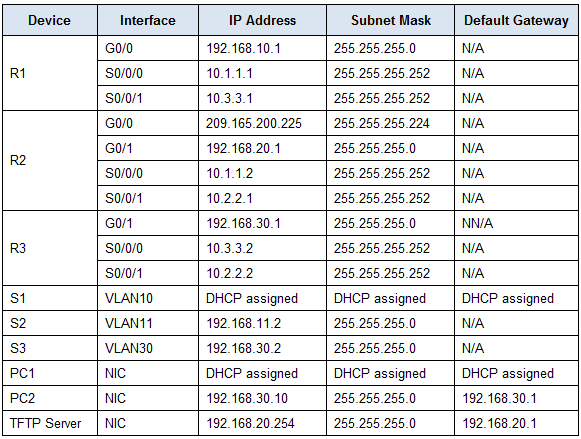Packet Tracer – Troubleshooting Enterprise Networks 3 (Instructor Version)
Instructor Note: Red font color or Gray highlights indicate text that appears in the instructor copy only.
Topology

Addressing Table

Background
This activity uses a variety of technologies you have encountered during your CCNA studies, including routing, port security, EtherChannel, DHCP, NAT, PPP, and Frame Relay. Your task is to review the requirements, isolate and resolve any issues, and then document the steps you took to verify the requirements.
Note: This activity begins with a partial score.
Requirements
DHCP
· R1 is the DHCP server for the R1 LAN.
Switching Technologies
· Port security is configured to only allow PC1 to access S1’s F0/3 interface. All violations should disable the interface.
· Link aggregation using EtherChannel is configured on S2, S3, and S4.
Routing
· All routers are configured with OSPF process ID 1 and no routing updates should be sent across interfaces that do not have routers connected.
· R2 is configured with a default route pointing to the ISP and redistributes the default route.
· NAT is configured on R2 and no untranslated addresses are permitted to cross the Internet.
WAN Technologies
· The serial link between R1 and R2 uses Frame Relay.
· The serial link between R2 and R3 uses HDLC encapsulation.
· The serial link between R1 and R3 uses PPP with PAP.
Connectivity
· Devices should be configured according to the Addressing Table.
· Every device should be able to ping every other device.
Troubleshooting Documentation

Verification Documentation
Capture output from verification commands and provide documentation proving that each of the requirements has been satisfied.
Instructor’s Note: The answer key for this section is left blank because there are many ways to verify the requirements.
Suggested Scoring Rubric
Packet Tracer scores 60 points. The troubleshooting documentation and instructor verification is worth 40 points.
